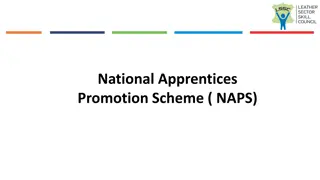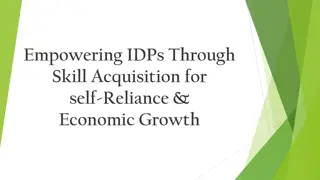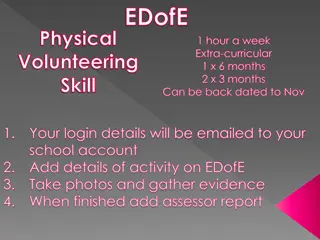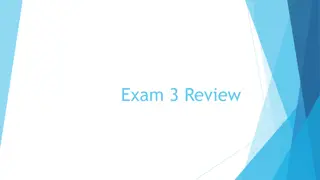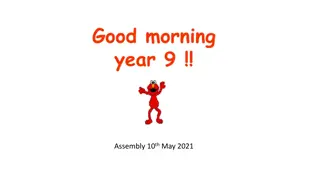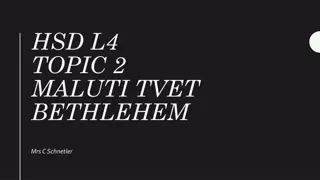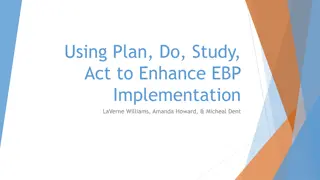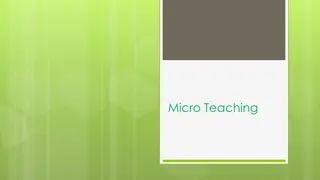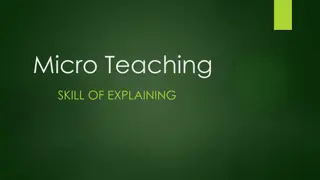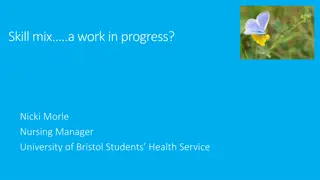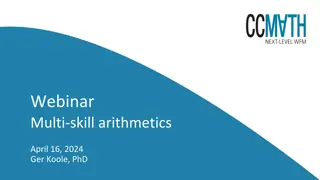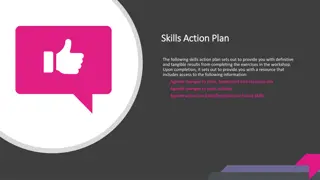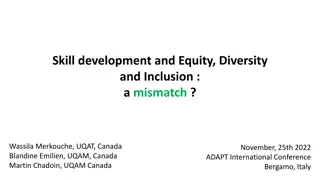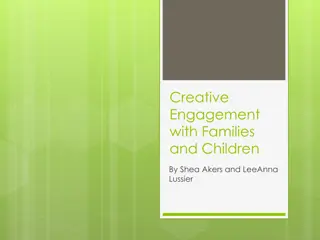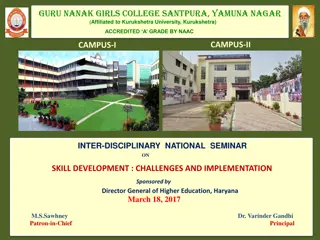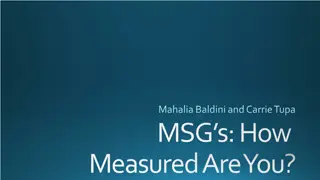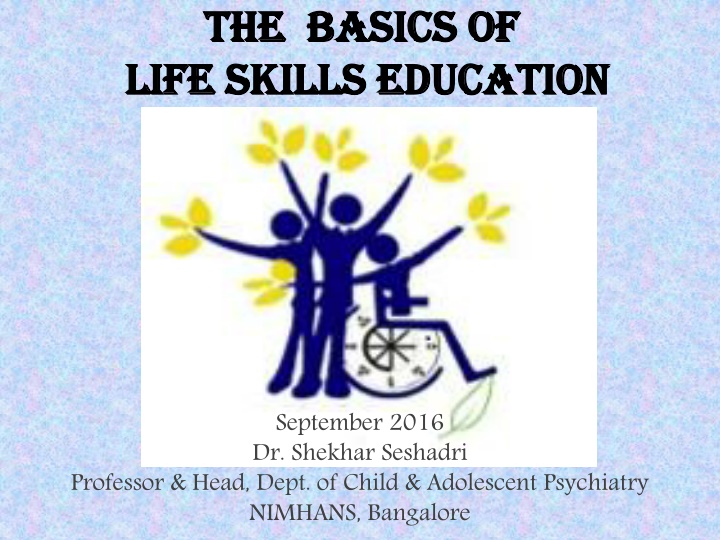
Life Skills Education: Importance and Context
Learn about the significance of life skills education, how different entities perceive and conceptualize life skills, and the importance of context in developing these skills for individuals facing various challenges.
Uploaded on | 1 Views
Download Presentation

Please find below an Image/Link to download the presentation.
The content on the website is provided AS IS for your information and personal use only. It may not be sold, licensed, or shared on other websites without obtaining consent from the author. If you encounter any issues during the download, it is possible that the publisher has removed the file from their server.
You are allowed to download the files provided on this website for personal or commercial use, subject to the condition that they are used lawfully. All files are the property of their respective owners.
The content on the website is provided AS IS for your information and personal use only. It may not be sold, licensed, or shared on other websites without obtaining consent from the author.
E N D
Presentation Transcript
The Basics of The Basics of Life Skills Education Life Skills Education September 2016 Dr. Shekhar Seshadri Professor & Head, Dept. of Child & Adolescent Psychiatry NIMHANS, Bangalore
What are life skills? What do different entities perceive and conceptualize to be life skills?
Just a bunch of skills...or do they have to have a context to be meaningful? Person Context Assertiveness skills: a child with disability versus for a child who has been sexually abused? Problem solving skills: a child who has substance abuse and is in conflict with the law versus for a child who has substance abuse following her mother s death? Situation Context Decision-making/ Critical thinking: in the context of sexuality i.e. Taking into consideration readiness for physical intimacy/ health & relational considerations etc versus in the context of conduct disorder i.e. taking into consideration other people s feelings, taking things that do not belong to us, consequences of certain actions...?
So, Life Skills for Whom? ... Where? ...In What Types of Situations/ Experiences? ... Addressing which problems and vulnerabilities?
Person Contexts: Children in Difficult Circumstances i. ii. Street & working children iii. HIV infected/ affected children iv. Disabled children v. Children affected by gender & sexuality vulnerabilities vi. Children in conflict with the law vii. Children affected by disaster/armed conflict Orphan & abandoned children
Contexts of Places: a) Institutionalized children Reside in child care agencies. Avail of care, protection and rehabilitation services. b) Non-institutionalized children Live within families and communities that expose them to multiple psychosocial risk factors such as physical/ sexual abuse, substance abuse, marital and family conflicts/violence; have social networks, but these are often severely compromised, placing them at times, at much higher risk of abuse and exploitation than institutional children; Often end up being placed in institutions.
Contexts of Spaces : Communities (within families from low socio- economic strata) Observation Homes/Remand Homes/Transitional shelters/State and NGO Residential homes Bus-stands/Railway Stations, Streets, Raid-Rescue spaces (trafficking) Government schools Vulnerable urban and rural communities
Context of Experiences: Single parent families Rejection & abandonment Parental marital conflict Loss & Grief (Death of Parents and/or other Attachment Figures) Alcohol dependency in parents Parent with mental illness/ disability Physical, sexual and emotional abuse (violence). Child labour and trafficking School drop-out/ learning problems Conflict with the law Political violence (ethnic cleansing/ genocide/ communal conflicts) Illness and disability
Emotional & Behavioural Consequences Internalizing Disorders: Anxiety (incl. dissociative disorders, bed-wetting) Adjustment Disorders/Dysphoria/ Depression PTSD Externalizing Disorders: Runaway behaviour Self-harm Anger/ aggression Substance abuse Life Skills Issues Sex and sexuality issues Bullying (perpetration and victim)
Life Skills Framework (1): Identifying Children s Life Skills Needs & Deficits Place & Space Context: Home/ School/ Family/ Public Space/ Social Spaces Basis of Understanding Child s Life Skills Needs/ Counsellor s Response & Intervention Impact on Child: Emotions/ Behaviours Type of Vulnerability & Child s Experience: Happy/Difficult/ Traumatic (Loss/ Abuse) Life Skills Deficits/ Gaps/ Needs
Life Skills Framework (2): Implementing Life Skills Interventions
Use of Life Skills Methods for Preventive & Promotive Purposes In vulnerable children (and others) With children who may be orphan/ abandoned/ chronically ill/ in conflict with the law... Who may have no psychiatric issues i.e. no severe emotional/ behaviour problems (or have mild issues) but are still at risk. Assuming that all children, even those not living in (obviously) vulnerable contexts need life skills in the absence of which they will be rendered vulnerable.
Using the Life Skill Lens to Address Psychiatric Problems (Curative Purposes) Therapeutic goals for child & adolescent psychiatric problems...to enable children to acquire certain life skills so as to overcome their emotional/ behavioural problems Internalization Disorders: Anxiety/ Depression Coping with stress Coping with (difficult) emotions Decision-making Communication Problem solving Externalization Disorders: ADHD/ Conduct Disorder Critical thinking Empathy Inter-personal relationships Problem-solving Decision-making
Life Skills Approach to Problem Issues: Discourse Mode Conversations Discussions Encouraging opinions, debate, perspective- taking Not providing value-based judgments/ opinions/ answers
How Life Skills Teaching Works All participants are learners; All participate in and contribute equally to the production of knowledge, which is a continuous dialogue; The learners are the subject and not the object of the process.
Experiential methodologies Theatre Narratives Story-telling Art Work
What to Consider when Teaching Life Skills? Content (depending on context/ needs of group) Method- slogan, movie, theatre-role play- proximal development. Involvement of children Discussion What s happening here? What are the feelings of the people involved ? How else could the situation be resolved ?
Components of this Life Skills Series (Community Child & Adolescent Mental Health Service Project/NIMHANS) Life Skills Series I: Emotional Development Life Skills Series II: Sex and Sexuality Life Skills Series III: Motivation and Conduct (Work-in-Progress) Life Skills Series IV: Substance Abuse
Life Skills in Action (1)... Objective: Emotional regulation in the context of trauma Method: Art and narratives; coping strategies (incl. relaxation techniques) Process (a): Close your eyes and think of a traumatic time/event in your life. Imagine the event/ time as an image (not a narrative/ not in words) like a still photograph. Now, draw it. Now describe it either to yourself or the person next to you. Discussion: What sort of images and feelings came back to you? Was it easy to express the emotions you felt? What or who helped you at the time? How did the issue resolve? How did you overcome your trouble? What else could have helped? Strategically convert children s responses into coping mechanisms by pointing out how they have used disclosure, social support, and problem solving strategies to cope. Process (b): Explain/ demonstrate how to use relaxation techniques when difficult emotions are experienced (guided imagery).
Life Skills in Action (2)... Objective: Self-awareness (with reference to anxiety) Method: Mask-making, Listing, narrative Process: Ask them to imagine how they would wear their fears and worries outside what they would look like if they were i) terrified; ii) worried; iii) confident. Provide children with the requisite materials and ask them to create a mask to wear for each of the three fear-worry feelings. When the children are ready with their masks, as each child to share their feelings about being terrified/ worried/ confident: I feel terrified when , I feel worried when , I feel confident when Next, ask them to list/ give examples of what things (that may be useful or necessary) they find themselves unable to do when they are terrified or worried. For example, when I am worried, I simply cannot concentrate on my school work Lastly, do a listing of how we experience anxiety what do we feel in our bodies (physical symptoms of pain/ discomfort/ black-outs/ fainting) and what do we feel in our minds? Discussion: Some people get so anxious that they are unable to deal with the situation, so they may either not be able to do the things they need to do or even run away from the situation that is causing them anxiety. Others have headaches/ body ache/ fainting provide explanatory models for pain. Discuss distraction, relaxation, routine/ planning...ways to manage anxiety...
Life Skills in Action (3)... Objective: Conflict resolution/ problem solving Method: Story Stems Process: Provide Narrative: John had worked very hard on a science project submission. The science teacher was very strict and particular and insisted on high standards of neatness and organization. John had stayed up late every night for nearly three weeks to make the project perfect. On the day of the final submission, he walked into the school yard, carefully carrying his completed project. He slipped on a step and the project folder fell from his hands; it flipped open to the first page. As he bent down to pick it up, Rahul, his classmate, ran past and stepped on the project folder, leaving a large muddy shoe-mark on the page that was open. Discussion: Do you think Rahul did this on purpose? Should John be angry with Rahul? How could he show he is angry? Which do you think would be the best way to show his anger? Should John have it out right there? And what should he do? Should John be understanding/ helpful about it? If so, how should he respond? What happens next/ how should John respond if: Rahul laughs and says: Haha, you lose! Rahul apologizes profusely and says: Hey, I am so sorry, I was in a tearing hurry as I was late for class I just didn t see your fallen project. Rahul apologizes profusely and says: As I was running, I saw your project fall and was rushing to pick it up when I over-stepped Rahul just looks at John, looks at the project and says nothing. He just moves on.
Life Skills in Action (4)... Objective: Decision-making in sexuality context Method: Film screening Process (a): Screen the video clip (Readiness for Physical Intimacy) and later discuss the situation. Discussion: What do you see here? What does the boy say to the girl; what does he ask her (What does he want)? What was her reaction? Was she allowed to refuse? Why do you think she refused? How did he react to her refusal? What is your opinion of his reaction? Why do you think he reacted that way? What were his feelings? After she said no what else could he have done instead of threatening her? How do we make decisions about getting into physical relationships? What have we learnt about consent and permission in sexual relationships? While asking somebody if they are interested in physical relationship. What are some issues we need to consider? (before asking them) Process (b): Role play a similar situation-- how they would respond in a similar situation?
Window Approach to Personal Safety and Sexual Decision-Making Body and General Well-Being Attraction and Love Privacy, Consent and Boundaries Health-Related Safety Relationships (Sexual) Abuse
Life Skills in Action (5)... Objective: Interpersonal relations and Empathy building in context of conduct issues Method: Pictures and narratives/ story-building, game Process (a): Give each sub-group a picture and ask them to create a little life story about the character(s) in the picture based on the following questions: What are these people s circumstances? What might they be feeling and experiencing? What are their difficulties? How can they be helped? Ask each sub-group to present their story in plenary. Ask others to comment on the story i.e. make observations, offer alternatives etc.
Process (b): Make teams & play a quiz game-- If you wanted to be helpful, what would you say or do? Statements for Quiz Game: If someone lost their purse If someone lost their pet If someone lost their family If someone lost their rank in the exam If someone got hurt If someone was insulted If someone was unfairly treated If someone fell ill If your friend was sad and you did not know why If someone was HIV+ If someone was the son of a parent who did something wrong If someone was a street child Someone who s favourite toy was stolen Someone who was falsely accused of stealing Someone who has a physical disability Discussion: What are some of the things we learnt about how to understand others feelings? What are some of the things we learnt about appropriate responses to others feelings? How will you use this learning in your life or everyday situations? Can you give one example of how you could do this? How do you think these skills of understanding others feelings and being helpful are important? How will they help your social and interpersonal relationships?
Life Skills in Action (6)... Objective: Assertiveness skills (&coping with peer pressure) in the context of substance abuse/ stealing Method: Theatre Process (a): Ask children to role play each to these situations/ how would it play out/how they would respond/ what would be the consequence: Scenario 1: Boy is convinced by peer group to try alcohol at a party... In a state of intoxication, he gets into a fight/ police are called. Scenario 2: Boy on the bus is urged by friend to steal lady s purse...someone on the bus sees him...he is caught by police. Process (b): Ask audience to give suggestions to the group what would the boy(s) have to do for the story to end differently...how could they refuse to do as they were told by peers/ what else could they have done in that situation? The role-plays are re-done, as per audience s direction/ suggestions. Discussion: What did you see happening here in round 1? Why did the boy get into trouble? What do you think his real problem was i.e. That got him into trouble? What did we learn about handling situations such as this?
Summary: Key Elements of Life Skills Program Implementation Context matters! What we are teaching children: application of life skills in contexts they live in/ realities they face No lectures, no didactic ways of communication! Methods, methods, creative methods, experiential methods! Processing of activities (recreational versus therapeutic/life skill purposes Meta-processes


